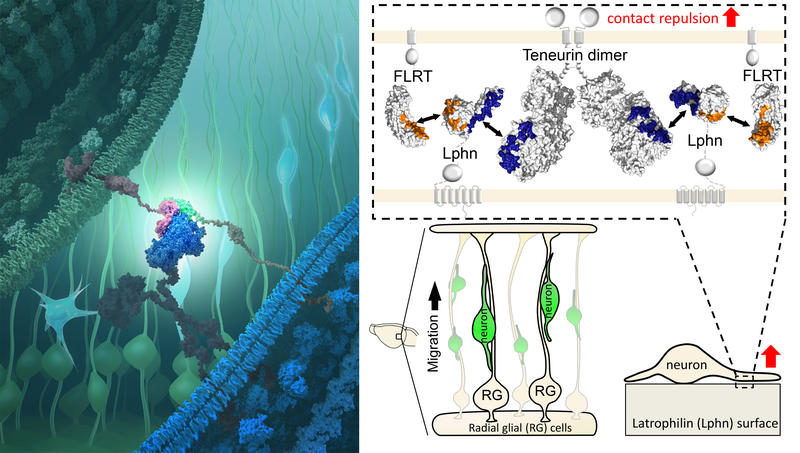Well anchored, the proteins Teneurin and FLRT are located on the surface of nerve cells. They are on the lookout for their partner protein, Latrophilin, on other neurons. When the three proteins come into contact, they interconnect and hold the cells together. They then trigger still largely unknown signalling cascades and thus promote the formation of a synapse at this site. Teneurin and its partner proteins are known to establish these important cell contacts in the brain. However, the role of these proteins early on during brain development, when neurons are not yet forming synapses, remained unknown.

The interaction between three proteins helps young nerve cells find their way in the developing brain. image credit: © Falconieri Visuals LLC; and del Toro, Carrasquero, Chu et al. Cell, January 2020
Using high-resolution X-ray crystallography, the team of Elena Seiradake at Oxford was finally able to find out more about how these proteins hold together. Working together with the teams of Matthieu Chavent at the University in Toulouse, and Rüdiger Klein at the Max-Planck Institute of Neurobiology in Germany, the researchers identified how these proteins guide migrating nerve cells as the brain forms. "Surprisingly, this happens not by cell-cell attraction, as in synapse formation, but by repulsion of the cells," explains Rüdiger. "This function was completely new and unexpected," adds Elena. Embryonic neurons often have only a cell body and short protrusions, called neurites. When Teneurin and FLRT on these structures bind to Latrophilin, the cells repel each other. As a result, the migrating cells partially lose their hold and progress more slowly. Thus guided, the cells reach their target brain area at the right time, where they mature and form a long axon.
However, when on the surface of such an axon, Teneurin and FLRT no longer trigger a repulsive reaction upon the encounter with Latrophilin. Here, the proteins pull the cells together, induce the formation of synapses and ultimately assemble into networks of communicating neurons. "The same proteins thus lead to completely different reactions - depending on their location on the cell," summarizes Elena.
"We now have ideal conditions to investigate further interactions of the proteins during brain development," explains Rüdiger. In our previous studies, the researchers were able to show that FLRT influences both the migration behaviour of young nerve cells and the formation of folds on the brain surface via interactions with its own binding partners. "It will be exciting to see whether and how Teneurin and Latrophilin are involved in these interactions" say the two researchers.
Reference
- Original research paper: https://www.cell.com/action/showPdf?pii=S0092-8674%2819%2931376-5
Elena Seiradake
21st January 2020